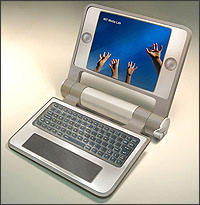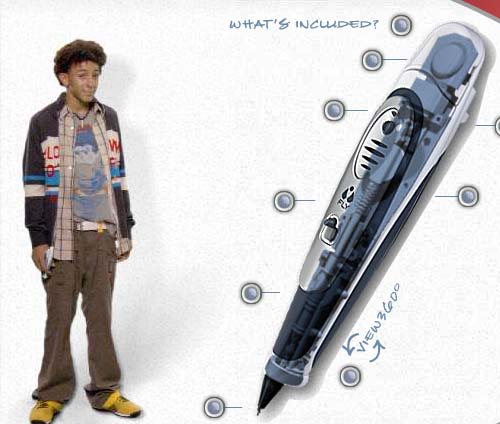 MIT has re-dubbed its $100 Laptop Project “One Laptop Per Child.” It’s probably a good sign that they’ve gotten children into the picture, but like many a program with sunny-sounding names and lofty goals, it may actually contain something less sweet. The hundred-dollar laptop is about bringing affordable computer technology to the developing world. But the focus so far has been almost entirely on the hardware, the packaging. Presumably what will fit into this fancy packaging is educational software, electronic textbooks and the like. But we aren’t hearing a whole lot about this. Nor are we hearing much about how teachers with little or no experience with computers will be able to make use of this powerful new tool.
MIT has re-dubbed its $100 Laptop Project “One Laptop Per Child.” It’s probably a good sign that they’ve gotten children into the picture, but like many a program with sunny-sounding names and lofty goals, it may actually contain something less sweet. The hundred-dollar laptop is about bringing affordable computer technology to the developing world. But the focus so far has been almost entirely on the hardware, the packaging. Presumably what will fit into this fancy packaging is educational software, electronic textbooks and the like. But we aren’t hearing a whole lot about this. Nor are we hearing much about how teachers with little or no experience with computers will be able to make use of this powerful new tool.
The headlines tell of a revolution in the making: “Crank It Up: Design of $100 Laptop for the World’s Children Unveiled” or “Argentina Joins MIT’s Low-Cost Laptop Plan: Ministry of Education is ordering between 500,000 to 1 million.” Conspicuously absent are headlines like “Web-Based Curriculum in Development For Hundred Dollar Laptops” or “Argentine Teachers Go On Tech Tutorial Retreats, Discuss Pros and Cons of Technology in the Classroom.”

Help! Help! We’re sinking!
This emphasis on the package, on the shell, makes me think of the Container Store. Anyone who has ever shopped at the Container Store knows that it is devoted entirely to empty things. Shelves, bins, baskets, boxes, jars, tubs, and crates. Empty vessels to organize and contain all the bric-a-brac, the creeping piles of crap that we accumulate in our lives. Shopping there is a weirdly existential affair. Passing through aisles of hollow objects, your mind filling them with uses, needs, pressing abundances. The store’s slogan “contain yourself” speaks volumes about a culture in the advanced stages of consumption-induced distress. The whole store is a cry for help! Or maybe a sedative. There’s no question that the Container Store sells useful things, providing solutions to a problem we undoubtedly have. But that’s just the point. We had to create the problem first.
I worry that One Laptop Per Child is providing a solution where there isn’t a problem. Open up the Container Store in Malawi and people there would scratch their heads. Who has so much crap that they need an entire superstore devoted to selling containers? Of course, there is no shortage of problems in these parts of the world. One need not bother listing them. But the hundred-dollar laptop won’t seek to solve these problems directly. It’s focused instead on a much grander (and vaguer) challenge: to bridge the “digital divide.” The digital divide — that catch-all bogey, the defeat of which would solve every problem in its wake. But beware of cure-all tonics. Beware of hucksters pulling into the dusty frontier town with a shiny new box promising to end all woe.
A more devastating analogy was recently drawn between MIT’s hundred dollar laptops and pharmaceutical companies peddling baby formula to the developing world, a move that has made the industries billions while spreading malnutrition and starvation.
Breastfeeding not only provides nutrition, but also provides immunity to the babies. Of course, for a baby whose mother cannot produce milk, formula is better than starvation. But often the mothers stop producing milk only after getting started on formula. The initial amount is given free to the mothers in the poor parts of the world and they are told that formula is much much better than breast milk. So when the free amount is over and the mother is no longer lactating, the formula has to be bought. Since it is expensive, soon the formula is severely diluted until the infant is receiving practically no nutrition and is slowly starving to death.
…Babies are important when it comes to profits for the peddlers of formula. But there are only so many babies in the developed world. For real profit, they have to tap into the babies of the under-developed world. All with the best of intentions, of course: to help the babies of the poor parts of the world because there is a “formula divide.” Why should only the rich “gain” from the wonderful benefits of baby formula?
Which brings us back to laptops:
Hundreds of millions of dollars which could have been more useful in providing primary education would instead end up in the pockets of hardware manufacturers and software giants. Sure a few children will become computer-savvy, but the cost of this will be borne by the millions of children who will suffer from a lack of education.
Ethan Zuckerman, a passionate advocate for bringing technology to the margins, was recently able to corner hundred-dollar laptop project director Nicholas Negroponte for a couple of hours and got some details on what is going on. He talks at great length here about the design of the laptop itself, from the monitor to the hand crank to the rubber gasket rim, and further down he touches briefly on some of the software being developed for it, including Alan Kay’s Squeak environment, which allows children to build their own electronic toys and games.
The open source movement is behind One Laptop Per Child in a big way, and with them comes the belief that if you give the kids tools, they will teach themselves and grope their way to success. It’s a lovely thought, and may prove true in some instances. But nothing can substitute for a good teacher. Or a good text. It’s easy to think dreamy thoughts about technology emptied of content — ready, like those aisles of containers, drawers and crates, to be filled with our hopes and anxieties, to be filled with little brown hands reaching for the stars. But that’s too easy. And more than a little dangerous.
Dropping cheap, well-designed laptops into disadvantaged classrooms around the world may make a lot of money for the manufacturers and earn brownie points for governments. And it’s a great feel-good story for everyone in the thousand-dollar laptop West. But it could make a mess on the ground.



 Two products that will most likely never be owned by the same teenager: The hundred dollar Laptop from MIT and the hundred dollar “pentop” computerized pen called the Fly. While the hundred dollar laptop (as we’ve said a
Two products that will most likely never be owned by the same teenager: The hundred dollar Laptop from MIT and the hundred dollar “pentop” computerized pen called the Fly. While the hundred dollar laptop (as we’ve said a  MIT has re-dubbed its
MIT has re-dubbed its 